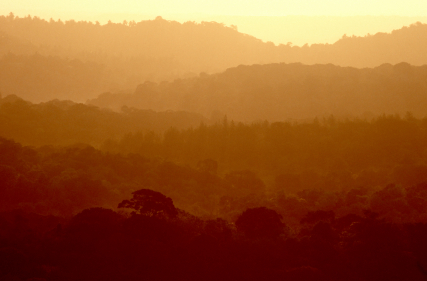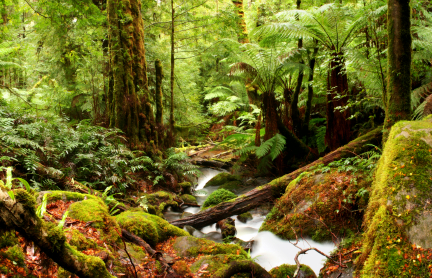An Introduction to Pitcairnia
Author: Melanie Dearringer1 Comment
Care and Culture, Classification
Pitcairnia is one of the largest genus of bromeliad plants. It includes 391 different species within the genus. They are second only to Tillandsias for number of species within the genus. Pitcairnia are typically found in South American highlands and range primarily within Brazil, Columbia and Peru.
However, they can also be found in a few other places throughout South and Central America.
A UNIQUE BROMELIAD

The forests of West Africa are known to have some of these bromeliads.
Pitcairnia also has the unique pleasure of boasting the only species in the entire bromeliad family that is not native to the new world. Pitcairnia feliciana makes its home in West Africa. It is suspected that the plant found its way to Africa through seed dispersal by migratory birds. The species is small with very thin, sparse leaves. The leaves have a few spines that increase towards the center of the rosette.
CHARACTERISTICS
Pitcairnia are primarily terrestrial and saxicolous meaning the grow either in the ground or attached to rocks. There are few species that can also be found growing as epiphytes in trees. Pitcairnia are characterized by softer drooping leaves, a few of which have spines, while others are remain spineless. This is opposed to many other genera of bromeliads that have stiff leaves.
Pitcairnia also often send up tall, brightly colored flower stalks. The flower stalks usually produce thin tube shaped flowers that project at right angles from the stalks. Flower stalks and flowers are typically found in pinks, reds, oranges and occasionally in yellows and whites. Many Pitcairnia are notorious for their long lasting inflorescence. They usually set on blooms in early summer and can last through late fall. In some cases the plant will maintain its inflorescence until November.
CARE AND USES

The plant does best in dense rainforest areas.
Pitcairnia are native to generally mild climates. They can be found in humid rain forests and more arid highlands. The usually prefer moderate temperatures ranging around 80 degrees. Some can handle a bit of frost if protection is provided. Pitcairnia can be excellent bedding plants in temperate climates. Some look similar to ornamental grasses when not in bloom and are stunning once the inflorescence grows. They can easily form thick mats and borders.
Pitcairnia also make excellent indoor plants. Depending on the species they prefer to be kept moist but not soggy. Like most bromeliads, Pitcarinia can be susceptible to root rot when their potting medium remains too wet. Use a well draining potting mix. You can purchase potting soil formulated specifically for bromeliads or you can mix your own using half regular potting mix and half perlite.
Many Pitcairnia will do well in dappled shade to full sun. Some species prefer humid environments and may require regular misting when grown indoors. Many can be grown in pots as small as six inches. Pitcairnia will produce offshoots or pups. The pups can be removed and planted separately or allowed to grow in clumps attached to the mother plant. If you desire to let the plant grow in clumps, you will want to use a slightly larger pot. You will need to separate and repot the plants once they become too pot bound.
SPECIES
There are many species of Pitcairnia that are available for growth in cultivation. They are difficult to find in conventional nurseries and garden stores, but are easily ordered online or found in specialty tropical plant retailers.
Pitcairnia undulata is very unique from other Pitcairnia and from other bromeliads. Unlike most bromeliads, this species grows very broad leaves on petioles or stems. The leaves are discolor with dark green on top and silver on the undersides. It produces a long flowering, simple red spike. This plant generates pups easily and forms clusters that reach two feet wide and up to 30 inches tall. The Pitcairnia undulata would make a very beautiful indoor plant. It is available from Tropiflora.
Pitcarinia andreana requires precise care. They are sensitive to temperature fluctuations and prefer mild temperatures that are not too hot or too cold. They are also very sensitive to water and require pure water. Distilled water or collected rainwater should be used to water this plant. Picairnia andreana is a small species that reaches about one foot tall and one foot wide. It has narrow silvery gray leaves and produces flowers that are orange toward the bottom and become yellow toward the top. If you are willing to devote some attention to this plant, it would be a lovely in an indoor container. It is also available from Tropiflora.
Pitcairnia xanthocalyx is much easier to maintain. It can withstand a broad range of temperatures, tolerating dips into the 20s as well as high heat. This plant prefers even moisture and does not like to be dry. It does best when exposed to part sun throughout the day. The plant has floppy dark green leaves that can resemble ornamental grass. It boasts a two foot tall flower stalk that, unlike most other Pitcairnia species, produces yellow and white flowers. This plant is best used as a landscape plant in moderate climates. It is difficult to find in cultivation, but can be purchased online, when available, from Strange Wonderful Things.
Pitcairnia maidifolia has broad dark green leaves that are deeply veined. It produces a tall pink and green flower spike with white tubular flowers. It prefers plenty of moisture and moderate shade.
Pitcairnia ringens produces light green leaves that are spineless and smooth. The leaves can grow up to 3 feet long. The plant sends up a conspicuous red flower spike that produces bright red showy flowers. The flower spike is very long lived and attracts hummingbirds and butterflies. Originally from Mexico, this plant prefers temperatures in the 80s with part shade. Pitcairnia ringens likes soils that are evenly moist and should not be allowed to dry out. This plant would make an attractive landscape plant in temperate climates, but can also be grown indoors. It can be ordered, when available, from Strange Wonderful Things.
Pitcairnia cataractae is a unique plant with dark green glossy leaves. It is a smaller Pitcairnia growing no more than two feet tall. The green flower spike is small and produces delicate white flowers that hang downward from the flower spike. It is saxicolous and native to cliffs among waterfalls in Columbia. It requires plenty of water, humidity and part shade to thrive. It is a rare plant, but can be ordered from Tropiflora.
TRY PITCAIRNIA IN YOUR COLLECTION
Pitcairnia is a broad genus that includes a vast amount of species. While sometimes difficult to find, they can make excellent landscape plants. They are especially ideal bromeliads for landscapes that are vulnerable to small kids and pets because most are soft and spineless. Many other bromeliads are stiff and often have sharp spines.
Pitcairnia can also make great indoor plants. Plenty of sunlight and even moisture should easily keep Pitcairnia happy indoors. Consider adding one of these unique species to your bromeliad collection.
Do you have a favorite species of Pitcairnia to grow?
Sources
Marks, Ken. “Pitcairnia felciana.” Bromeliad Society International.
“Pitcarinia ringens.” StrangeWonderfulThings.
“Pitcairnia xanthocalyx.” StrangeWonderfulThings.
“Pitcarinia.” Tropiflora.
Saraiva, D.P. and Forzza, R.C. “Pitcairnia frequens (Bromeliaceae), a neglected new species from Morro dos Seis Lagos, Amazonas, Brazil.” Phytotaxa 69:57-63. 2012.
“Tropical Plant Catalog.” Top Tropicals.
One response on “An Introduction to Pitcairnia”
Leave a Reply

Resource Download
Hechtia Care Cheat Sheet
Learn how to care for your Hechtia bromeliad with this quick and easy informational guide.
Learn More
Ask an Expert
Questions about bromeliads?
Our experts love a challenge!
Photo of the Week
Submit your photo to be featured on the blog!
More Photo of the Week Winners
Submit Photo








Hello melanie–i contacted you a couple of months back to ask permission to reprint your article on carnivorous bromeliads. Now i have found another of your great articles on pitcairnias and wonder if i might again have permission to reprint this in my april 2014 newsletter.